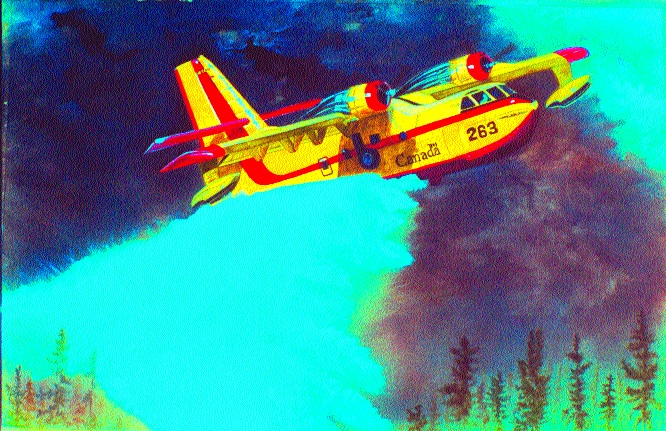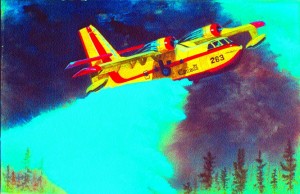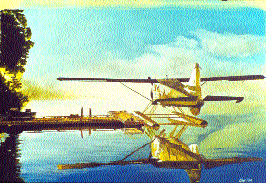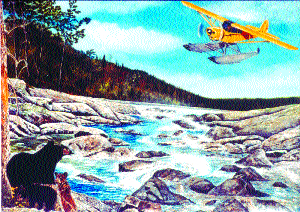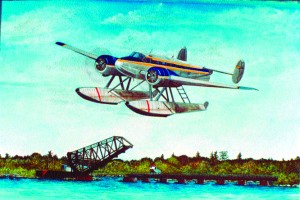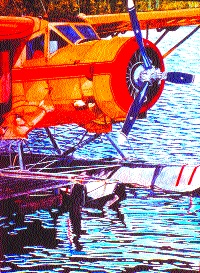By Larry W. Bledsoe
Do you ever dream of someday visiting some fascinating locale you’ve read or heard about? There are several places on this exciting planet that I long to visit and hope to someday. One is Fort Frances, Ontario, Canada.
Why Fort Frances, which is just across the border from Minnesota? Well, that’s where aviation artist Cher Hogan and her husband Murray live, and her paintings make it seem irresistible. According to Hogan, floatplanes are still a way of life there, and in the summer months it’s possible to see all types of planes, including many vintage aircraft, on floats carrying visitors and supplies to remote Canadian lakes.
Hogan specializes in floatplanes and uses picturesque Canadian landscapes as the background for her paintings. Based on many of her paintings, I think that living there, with all the vintage aircraft in the area, must be like stepping back into the past.
Hogan, self-taught, is unusually talented for someone without formal art training. Museums and corporations, as well as private collectors, have commissioned most of her works. Several of her paintings have been published.
One of her paintings features a rare bird that is a product of Kansas, but one you would expect to see on floats; that is Beechcraft’s twin-engine D-18.
The Beech 18 has played an enormous role all over North America’s rugged bush country and is still faithfully plying the skies. Her Beech 18 print titled “Beech Party,” shows one turning downwind, with a party of American fishermen returning with the spoils of a successful fishing trip.
A more modern workhorse is the magnificent Canadair CL-215 water bomber, built specifically for fighting forest fires. For the past several fire seasons, two of these effective machines have received a lot of praise from Los Angeles area fire fighters for the exceptional work they have done.
Hogan’s print, “Bull’s-eye,” shows a CL-215 dropping its 1,200-gallon payload of water on a forest fire. You can almost hear the change in the sound of its two mighty Pratts as the pilot pulls back on the yoke to clear the trees in the dangerously thin air present at the fire scene.
Hogan’s paintings capture other vintage aircraft that are still flying today. The Noorduyn Norseman is a classic from the mid-1930s. The de Havilland Beaver came along in the late forties, and the de Havilland Otter started to appear in the mid-1950s.
Of the three, the Noorduyn Norseman was the fastest, with a cruise speed of 134 mph. It is slightly larger than the Beaver but weighs a ton more, which is probably why it has a smaller payload of only 1,690 pounds. This rugged single-engine, high-wing transport was powered by several different power plants, the most common being the Pratt & Whitney R-1340, which delivered 600 hp.
A large number of these transports, the Noorduyn model Mark VI, were purchased by the U.S. Army during World War II, and designated the C-64. They stayed on operational duty until the early 1950s. The Army Corps of Engineers was the main user of the float configured Norseman, but it served just as well on land as a cargo plane or air ambulance, and in other roles such as a navigational trainer.
The Norseman had a welded steel tube fuselage with stubs for wing attachment. The fabric-covered high wing was externally braced. The fuselage was covered with aluminum at the front end and fabric aft of the cockpit. The doors were of metal and wood construction and could be completely removed to form a large freight-load opening. The artist’s painting, “Noble Norseman,” shows this workhorse of the north patiently waiting and ready for its next payload.
The de Havilland Beaver was the smallest of the three but could carry a ton of cargo, if you could get it through the door. Originally designed for use as a bush plane in the Canadian and Alaskan wilds, it was bought in quantity by the Army at the beginning of the Korean War and designated L-20, later changed to U-6. It was a six-place aircraft, but one source says the plane had to be modified in order for a stretcher patient to fit. The Army version was powered by a 450 hp Pratt & Whitney R-985 engine and cruised at 125 mph.
Hogan’s painting of the de Havilland Beaver, “Misty Morn,” was one of the award winners at the Seattle Museum of Flight’s art show. It depicts a typical scene around floatplane operations, where at five a.m., during the long summer season, the pilot’s day has already begun. Still waters, and a light fog that will shortly be burned off by the sun’s rays, give the viewer a feeling of deep serenity.
For shear brute size and load-carrying ability, the 11-place de Havilland Otter has to take the prize for single-engine aircraft. The Otter is almost eight feet longer, but 600 pounds lighter than the Norseman, yet it can carry 1,200 pounds more cargo with the same size 600-hp engine. The Otter is the slowest of the three with a cruise speed of 120 mph.
“Windy Point” shows an Otter on final over a freight train that is crossing a bridge. It’s easy to imagine yourself in this picture, and to feel the stiff wind coming across the lake and hear the “clickity clack” of the train wheels as well as the rumble of the throttled-back radial.
Hogan wants the viewer to see the image with more than their eyes. She wants them to smell, hear and feel the scenes as she does! For her, mood is just as important as accurately depicting the airplane. Her success in doing that becomes apparent when you take the time to lose yourself in her paintings.
The artist has started a new series of paintings called “With a View to the North.” The first in the series is titled “Cubs of a Feather.” Hogan says that what she is portraying is a picturesque area known as Rushing River, about two and a half hours north of Fort Frances.
“When I think of Super Cubs, I picture them yellow, even though they, of course, come in a wide array of color schemes,” says Hogan. “A little yellow Super Cub owned by a very wonderful lady and good friend of mine, Charlotte Parish, inspired the one depicted.”
The artist notes that her love of the wilderness, water, wildlife, and of course airplanes, inspired this particular painting. She says that black bears are a very common sight in northwest Ontario, so it seemed only fitting to put one of her favorite wild animals with one of her all time favorite airplanes, the Cub.
Larry W. Bledsoe is owner of Bledsoe’s Aviation Art, a gallery on Cable Airport in Upland, Calif. He is an associate member of the American Society of Aviation Artists. For questions, he can be contacted at (909) 986-1103 or at Larry@AirportJournals.com.











